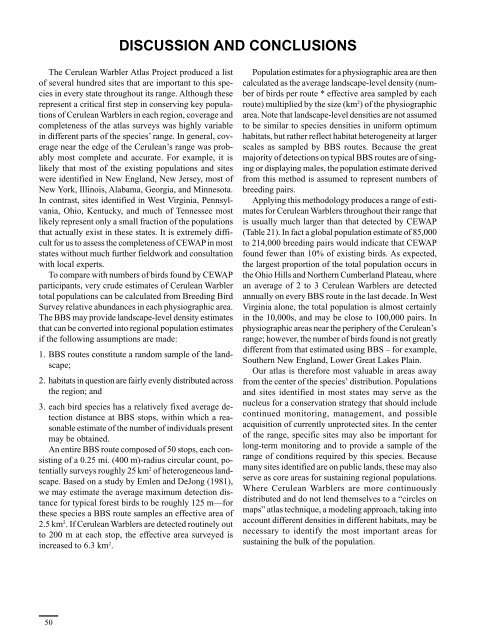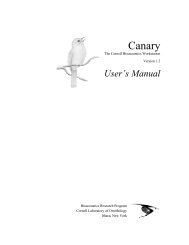An Atlas of Cerulean Warbler Populations - Cornell Lab of Ornithology
An Atlas of Cerulean Warbler Populations - Cornell Lab of Ornithology
An Atlas of Cerulean Warbler Populations - Cornell Lab of Ornithology
You also want an ePaper? Increase the reach of your titles
YUMPU automatically turns print PDFs into web optimized ePapers that Google loves.
DISCUSSION AND CONCLUSIONSThe <strong>Cerulean</strong> <strong>Warbler</strong> <strong>Atlas</strong> Project produced a list<strong>of</strong> several hundred sites that are important to this speciesin every state throughout its range. Although theserepresent a critical first step in conserving key populations<strong>of</strong> <strong>Cerulean</strong> <strong>Warbler</strong>s in each region, coverage andcompleteness <strong>of</strong> the atlas surveys was highly variablein different parts <strong>of</strong> the species’ range. In general, coveragenear the edge <strong>of</strong> the <strong>Cerulean</strong>’s range was probablymost complete and accurate. For example, it islikely that most <strong>of</strong> the existing populations and siteswere identified in New England, New Jersey, most <strong>of</strong>New York, Illinois, Alabama, Georgia, and Minnesota.In contrast, sites identified in West Virginia, Pennsylvania,Ohio, Kentucky, and much <strong>of</strong> Tennessee mostlikely represent only a small fraction <strong>of</strong> the populationsthat actually exist in these states. It is extremely difficultfor us to assess the completeness <strong>of</strong> CEWAP in moststates without much further fieldwork and consultationwith local experts.To compare with numbers <strong>of</strong> birds found by CEWAPparticipants, very crude estimates <strong>of</strong> <strong>Cerulean</strong> <strong>Warbler</strong>total populations can be calculated from Breeding BirdSurvey relative abundances in each physiographic area.The BBS may provide landscape-level density estimatesthat can be converted into regional population estimatesif the following assumptions are made:1. BBS routes constitute a random sample <strong>of</strong> the landscape;2. habitats in question are fairly evenly distributed acrossthe region; and3. each bird species has a relatively fixed average detectiondistance at BBS stops, within which a reasonableestimate <strong>of</strong> the number <strong>of</strong> individuals presentmay be obtained.<strong>An</strong> entire BBS route composed <strong>of</strong> 50 stops, each consisting<strong>of</strong> a 0.25 mi. (400 m)-radius circular count, potentiallysurveys roughly 25 km 2 <strong>of</strong> heterogeneous landscape.Based on a study by Emlen and DeJong (1981),we may estimate the average maximum detection distancefor typical forest birds to be roughly 125 m—forthese species a BBS route samples an effective area <strong>of</strong>2.5 km 2 . If <strong>Cerulean</strong> <strong>Warbler</strong>s are detected routinely outto 200 m at each stop, the effective area surveyed isincreased to 6.3 km 2 .Population estimates for a physiographic area are thencalculated as the average landscape-level density (number<strong>of</strong> birds per route * effective area sampled by eachroute) multiplied by the size (km 2 ) <strong>of</strong> the physiographicarea. Note that landscape-level densities are not assumedto be similar to species densities in uniform optimumhabitats, but rather reflect habitat heterogeneity at largerscales as sampled by BBS routes. Because the greatmajority <strong>of</strong> detections on typical BBS routes are <strong>of</strong> singingor displaying males, the population estimate derivedfrom this method is assumed to represent numbers <strong>of</strong>breeding pairs.Applying this methodology produces a range <strong>of</strong> estimatesfor <strong>Cerulean</strong> <strong>Warbler</strong>s throughout their range thatis usually much larger than that detected by CEWAP(Table 21). In fact a global population estimate <strong>of</strong> 85,000to 214,000 breeding pairs would indicate that CEWAPfound fewer than 10% <strong>of</strong> existing birds. As expected,the largest proportion <strong>of</strong> the total population occurs inthe Ohio Hills and Northern Cumberland Plateau, wherean average <strong>of</strong> 2 to 3 <strong>Cerulean</strong> <strong>Warbler</strong>s are detectedannually on every BBS route in the last decade. In WestVirginia alone, the total population is almost certainlyin the 10,000s, and may be close to 100,000 pairs. Inphysiographic areas near the periphery <strong>of</strong> the <strong>Cerulean</strong>’srange; however, the number <strong>of</strong> birds found is not greatlydifferent from that estimated using BBS – for example,Southern New England, Lower Great Lakes Plain.Our atlas is therefore most valuable in areas awayfrom the center <strong>of</strong> the species’ distribution. <strong>Populations</strong>and sites identified in most states may serve as thenucleus for a conservation strategy that should includecontinued monitoring, management, and possibleacquisition <strong>of</strong> currently unprotected sites. In the center<strong>of</strong> the range, specific sites may also be important forlong-term monitoring and to provide a sample <strong>of</strong> therange <strong>of</strong> conditions required by this species. Becausemany sites identified are on public lands, these may alsoserve as core areas for sustaining regional populations.Where <strong>Cerulean</strong> <strong>Warbler</strong>s are more continuouslydistributed and do not lend themselves to a “circles onmaps” atlas technique, a modeling approach, taking intoaccount different densities in different habitats, may benecessary to identify the most important areas forsustaining the bulk <strong>of</strong> the population.50
















